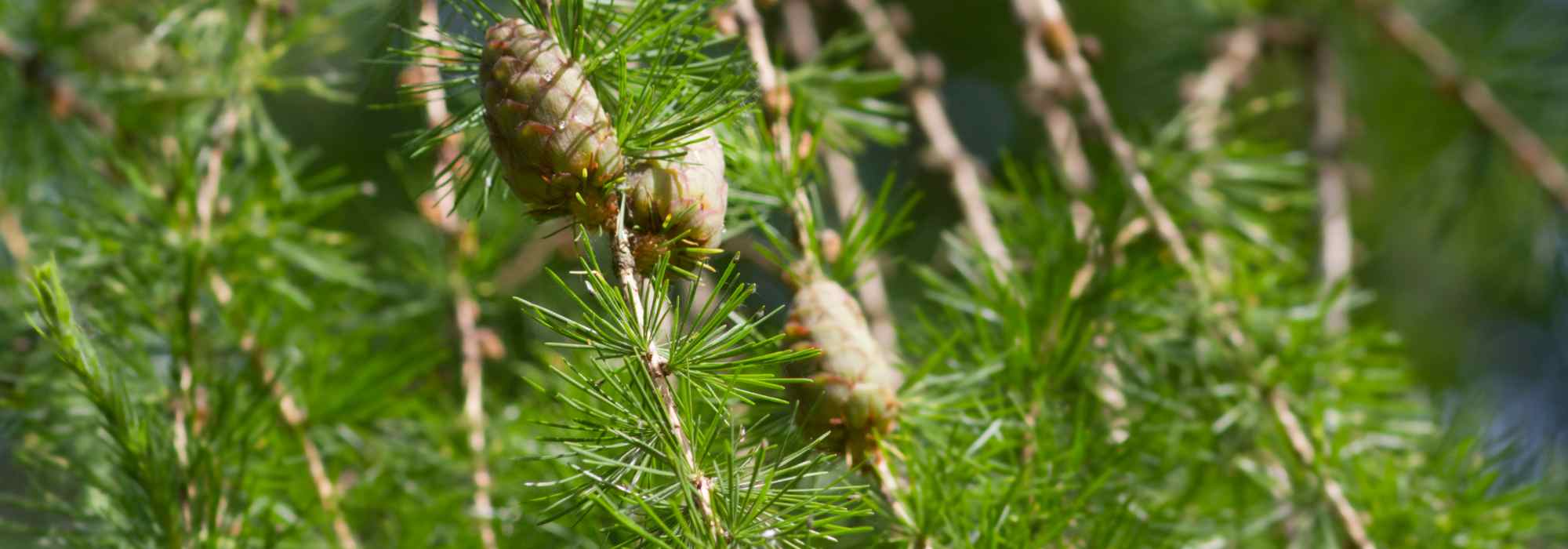
Larch, Larix: planting, pruning and care
Contents
Larix, larch, in a nutshell
- Larches are mountain or lowland conifers of very cold climate that notably blaze into colour and shed needles in autumn, then don a pretty pale green in spring.
- Typical species have a magnificent conical habit, while rock-garden cultivars display various habits — globose, weeping, pyramidal with twisted branches in Larix kaempferi ‘Diana’ — with heights ranging from 0.75 to 6 m.
- These conifers are fast-growing, slow in dwarf forms, prefer cool to cold climate and light or stony, well-drained soil, except species Larix laricina, which occurs in North American turf moors.
Word from our expert
Larches also sometimes nicknamed “mountain pines” are forest trees generally mountainous of the Northern Hemisphere, highly valued for their production of rot-resistant wood not least because they reach heights of 30 m with relatively rapid growth. These conifers, whether European (Larix decidua), Japanese (Larix kaempferi, syn. leptolepis) or American (Larix laricina), are all very hardy and lose all their needles in winter. This rare phenomenon among conifers gives rise in autumn to splendid foliage colours in rust and golden-yellow tones that make larch as attractive in a garden as iconic bald cypress or Metasequoia, conifers also deciduous, a little less hardy, to be reserved exclusively for cool to moist soils. Their bare branches also have the advantage of not shading precious light in winter.
Larch is also prized as an ornamental tree because its graceful, slightly trailing branches give a light silhouette that fills with fresh green tones in spring when the needles reappear and with warm tones in autumn. Ovoid cones, purplish becoming beige, are fairly small, reminiscent of those of spruces or firs, and nicely adorn the bare branches throughout winter. Pinkish-grey tones of its scaly bark add to the charm of its winter outline. Flowering occurs in March–April while tufts of fine pale-green needles barely emerge from their bud. The clustered arrangement of the needles resembles that of cedars, except that they are not prickly.
You can plant a larch in a small garden or rockery thanks to the availability of dwarf cultivars among the three species mentioned. You can pair them without fear with other dwarf conifers such as pines or junipers, to which they will bring an original touch.
Description and botany
Botanical data
- Latin name Larix
- Family Pinaceae
- Common name Larch, red spruce
- Flowering March to April
- Height between 0.75 and 30 m
- Exposure sun or partial shade
- Soil type any deep, fresh, rather acidic to neutral soil
- Hardiness Excellent (-40 °C)
Larix belong to family Pinaceae like Pines, firs or cedars. Genus now comprises 11 species, noting that Chinese larch belongs to a different genus containing only one species, Pseudolarix amabilis. The latter differs from larches notably by slow growth, a more spreading crown becoming rounded with age, male flowers in clusters instead of being solitary and above all a preference for warm climates such as Mediterranean climate.
Larix occupy coldest regions of Northern Hemisphere up to Arctic tree line and from sea level up to alpine zone.
Emblematic species of French Alps is European larch, Larix decidua, which grows between 1200 and 1400 m altitude, in central and southern Europe where it associates with Scots pine below 400 m and with Swiss stone pine at higher altitude. In mild conditions it shows exceptional growth rate, reaching almost 20 m with 8 m spread in 20 years and can reach 30 or 40 m. In mountains, sometimes 30 years are needed before it exceeds 4 m, which explains why its wood is so hard and durable. Longevity reaches 600 years.
This conifer has a fairly narrow, conical habit that flattens slightly with age. Branches, widely spaced, are horizontal and bear fine pendulous shoots towards base while they are erect near the top. Bark greyish-pink to reddish-brown cracks vertically and forms scales with age. Twigs, quite rigid and thin, are ribbed. This tree develops a deep, extensive root system that anchors it firmly and allows it to resist wind.
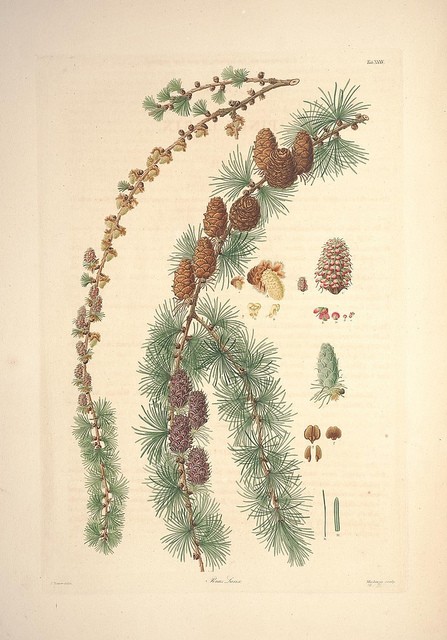
Larix decidua – botanical illustration
Soft, fine needles of a bright spring green turning to bluish green are grouped in vascular bundles of 30 to 40 (between 10 and 60 across the genus) on dwarf shoots and measure 2 to 5 cm in length. They are marked beneath by two bands of white dots. Along long shoots, needles can be solitary and arranged in a spiral. They turn golden yellow and rusty in autumn before falling.
Male and female flowers are separate as in all conifers but appear on the same specimen. Male flowers are more numerous in lower part of crown than female ones although they can be found on same shoot. Yellow stamens borne by male aments distributed singly along fine shoots release their pollen in late March–early April. Female conelets, 1–2 cm long, have reddish, greenish or yellowish scales and point skywards. After fertilization, green cones, sometimes becoming purplish, enlarge then lignify and reach maturity in late summer. Scales, more or less undulate or turned back depending on species, are backed by a pointed bract that usually protrudes beyond the scale. In Japanese larch, rather rounded cones have scales giving them the look of small roses. Larch cones, 1–5 cm long, are erect and persist on the tree for several years after seed release unlike Pseudolarix, which adds much charm to bare winter shoots. Seeds are winged, facilitating wind dispersal in late summer.
Dwarf shoots end with a bud that can produce a new vascular bundle of needles, a male or female cone or transform into a long shoot.
Larch is a light-demanding, pioneer tree, capable of improving poor or degraded soils thanks to its litter layer and of great hardiness (down to −40 °C). Its resinous wood, durable, hard and resistant to moisture, is highly prized for making doors and windows, outdoor furniture, ship structural timbers, roof shingles, railway sleepers… It is also used for wood pulp production and as firewood (one of best among resinous trees). A medicinal anti‑infective resin is extracted from its needles and bark, called “Venice turpentine” or “Briançon manna”.

Larix decidua or European larch: male flowers (yellow aments) and female (red cones) on same specimen / cones and small soft needles / cracked, scaly bark
Read also
Major diseases and pests of conifersMain larch varieties

Larix kaempferi Diana - Larch
- Height at maturity 6 m
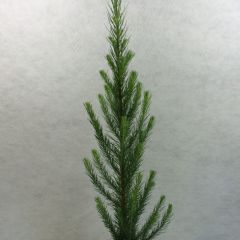
Larix kaempferi Jakobsens Pyramid - Larch
- Height at maturity 3,50 m
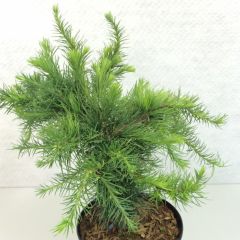
Larix decidua Little Bogle - Larch
- Height at maturity 75 cm
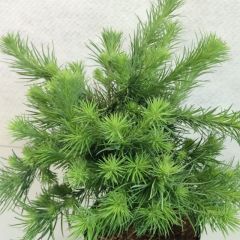
Larix kaempferi Blue Dwarf - Larch
- Height at maturity 1,20 m
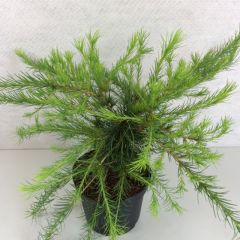
Larix laricina Arethusa Bog - Larch
- Height at maturity 1,20 m
Discover other Larix - Larch
View all →Available in 1 sizes
Available in 1 sizes
Available in 1 sizes
Available in 1 sizes
Available in 1 sizes
Available in 1 sizes
Available in 1 sizes
Available in 1 sizes
Available in 1 sizes
Available in 1 sizes
Planting
Where to plant larch?
Despite montane origins, European larch adapts very well to cultivation on plains. Its cousin Japanese larch (Larix kaempferi) however shows better growth in a mild, humid coastal climate, at least during its first 20 years. American larch (laricina) is adapted to the poor, acidic swampy soils of Canadian sphagnum turf moors, which does not prevent it, like the other two species (decidua and kaempferi), from preferring fresh but well-drained soil.
Avoid arid situations, heavy compact clay soils, urban pollution and excess lime, except for European larch which is not very demanding about pH.
They thrive in very sunny spots, near a water source, but dwarf varieties also tolerate partial shade. Growth of European larch is 4–5 m in 10 years, Japanese larch 5–6 m.
When to plant?
Best planting time is October to November or February to March when leaves have not yet appeared.
How to plant?
Choose a sunny to part-shaded spot for dwarf varieties. Soil must be deep so roots can establish properly. Choose fairly young plants so they can develop their taproot.
- Submerge pot in a bucket of water to soak it thoroughly.
- Untangle roots if they have been circling in the pot.
- Dig a hole three times wider than the rootball and loosen soil around it with fork tines.
- Add a few shovelfuls of coarse sand and heather soil to acidify soil if needed and ensure good drainage around the roots. In heavy soil, opt for planting on a mound or within a rockery.
- Add well-rotted manure or compost if soil is poor.
- Place the young plant in the planting hole, checking that the collar is not buried or too deeply covered.
- Replace soil and firm lightly.
- Water.
- Drive in 2 to 3 stakes around the rootball for tall-growing trees, even though windage is lower than for evergreen conifers.
If you want to grow a larch in a pot, choose a deep pot, even for a specimen trained as bonsai, and make a mix of coarse sand, heather soil and potting compost added to garden soil. To form an informally trimmed larch hedge, space young plants 1 to 2 m apart.
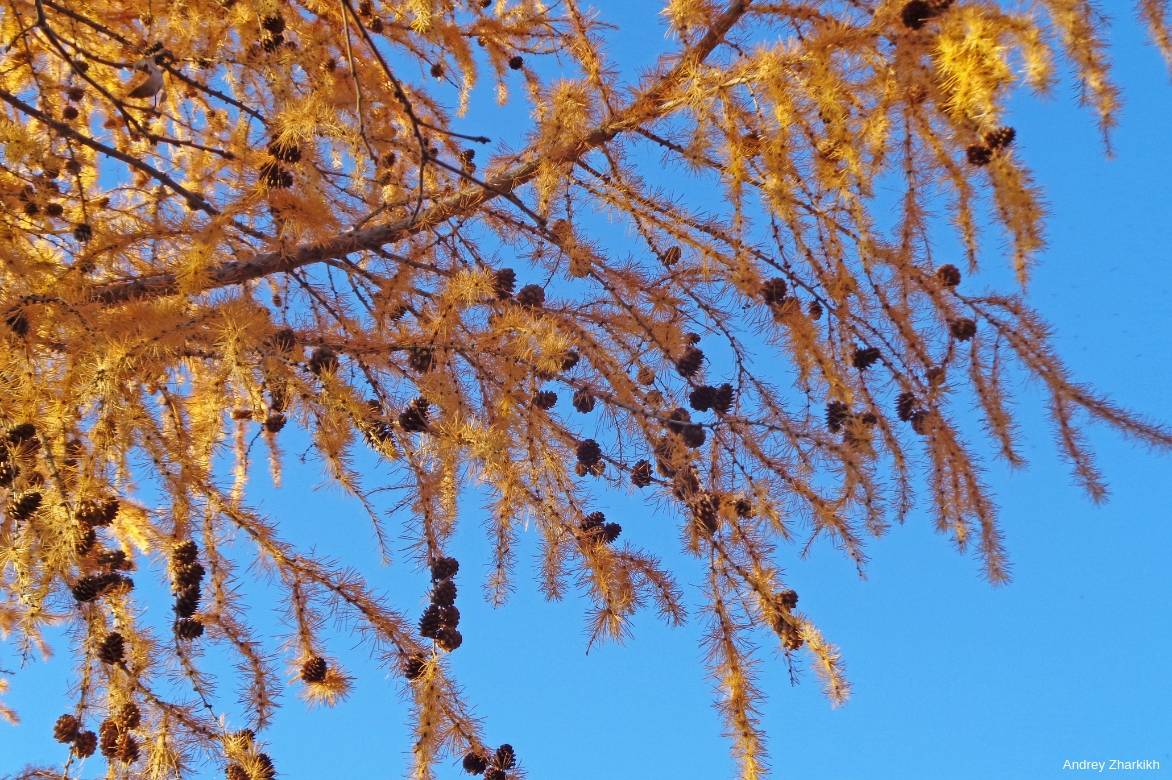
Larch needles turn golden yellow in autumn
Larix maintenance and pruning
Water abundantly during first two years after planting and during prolonged drought.
Canker can sometimes cause problems in wet, cold conditions, manifesting as oozing deformities of trunk and branches. Cut and burn affected parts where possible.
Pruning of larch
Pruning is not necessary, but you can enhance an original habit such as that of a globose or weeping larch by shortening shoots in February–March. A hedge of larches intended to serve as a windbreak can also be pruned easily once or twice a year, in winter and/or in June for faster healing.
Multiplication
The simplest method of propagation is to sow botanical species and propagate cultivars by cuttings in late August to early September.
Propagation by cuttings
Prepare a deep pot by filling it with potting compost mixed with sand and turf.
- Take semi-ripe shoots by pulling on them to obtain a heel (piece of bark).
- Remove leaves from two-thirds of their length.
- Dip the base in plant hormone.
- Insert the cuttings to two-thirds of their length, avoiding them touching each other.
- Firm gently all around to eliminate air pockets and ensure good contact between potting compost and cutting.
- Keep them under cover throughout winter, placing a sheet of clear plastic over them.
- In spring, remove from the pot any cuttings that have not broken bud and keep the others undisturbed until autumn in a shaded area while maintaining freshness of the substrate.
- Plant out your plants the following spring into open ground.
Sowing
- Sow in autumn seeds collected at the end of summer, under a cold frame, or wait until spring after subjecting them to a cold treatment for about three months.
- Space seeds about 10 cm apart to allow transplanting young plants without damaging them the following autumn.
Uses and associations
Upright larches, vigorous or moderately vigorous, such as ‘Diana’ (up to 6 m tall) make magnificent subjects to plant in a park, as a solitary specimen within a short grass meadow or in a line along an avenue. Avoid planting this type of conifer near buildings or in towns as they may languish. You can also create a perfect windbreak in a mid-mountain climate, preferably north-facing (the ubac), or in high-mountain areas where hostile conditions are not a problem regardless of exposure. By contrast larch appreciates clean air, tolerates severe cold and wind.
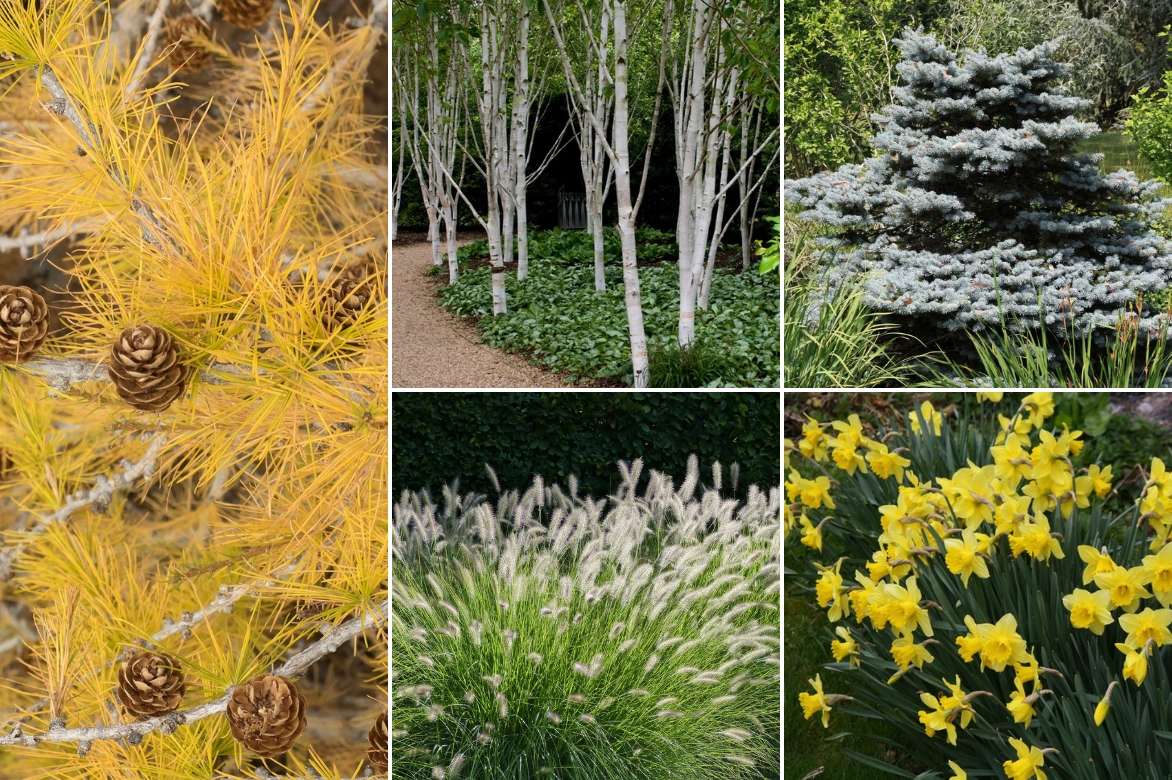
An example of a planting: a few clumps of Daffodils to brighten spring, Larix decidua ‘Little Bogle’ for example, Picea pungens ‘Glauca Globosa’, Betula utilis var. jacquemontii and Pennisetum alocuperoides ‘Hameln’
Simply provide it with soil that stays fairly cool in summer and a rather sunny exposure (roots in shade and crown in sun).
Graphic qualities of rock garden conifers, whether globe-shaped like Larix decidua ‘Little Bogle’, weeping like L. kaempferi ‘Blue Rabbit Weeping’ or somewhat tousled like L. laricina ‘Arethusa Bog’, are naturally suited to contemporary garden design, which favours the aesthetic of forms over profusion of colours. Slow to moderately fast-growing, these specimens are also suitable for a small romantic or Japanese-style garden, at the back of a border paired with ericaceous plants such as camellias and rhododendrons.
As a solitary specimen, against a backdrop of evergreen conifers, the larch’s autumn blaze will make a statement. You can also pair it with other trees in fiery colours such as Liquidambar or various maple varieties.
Learn more
Discover our range of Larches: varieties for every garden
- Subscribe!
- Contents
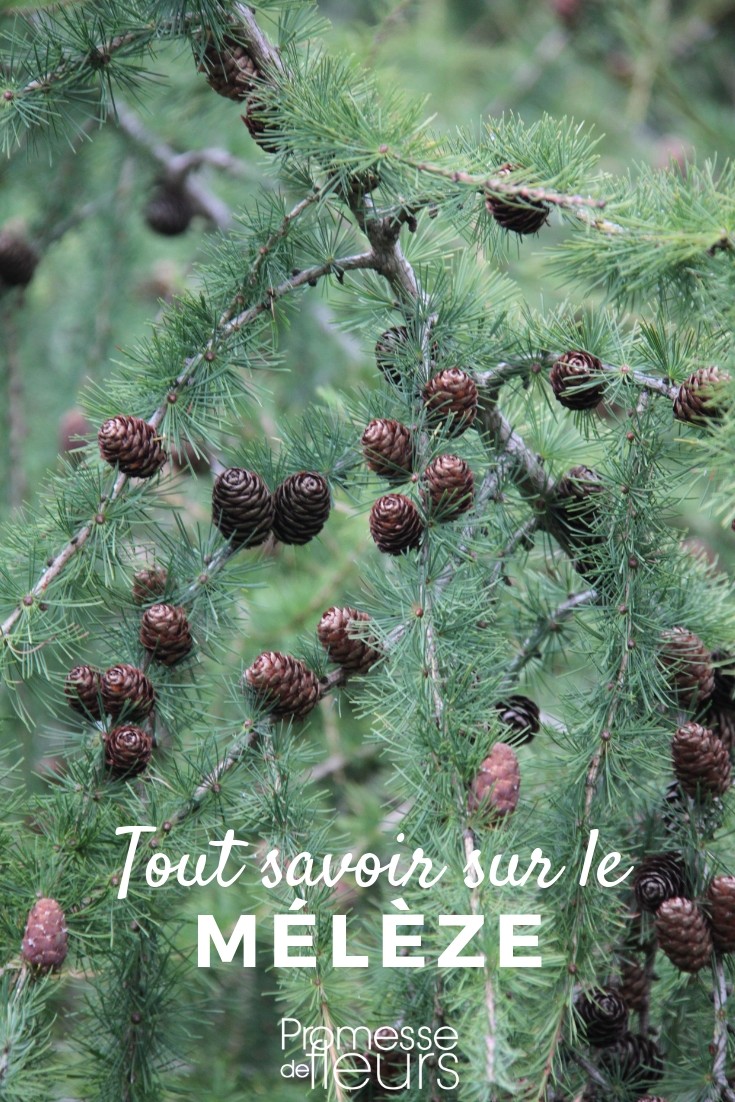































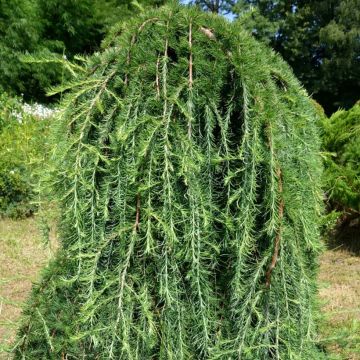
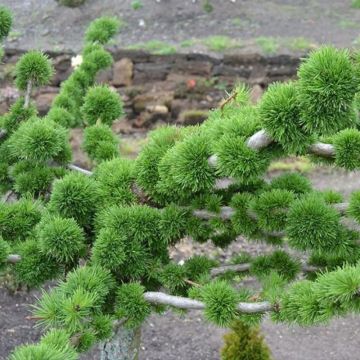
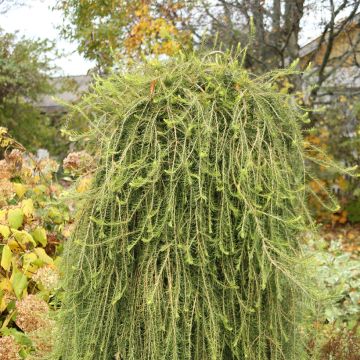
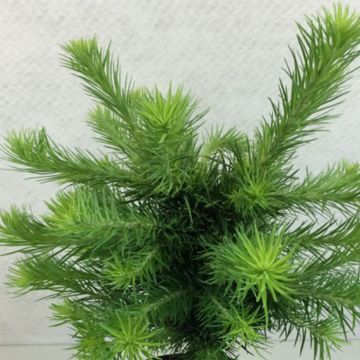



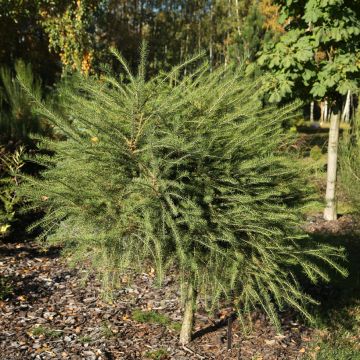
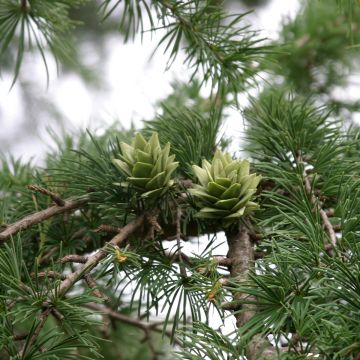
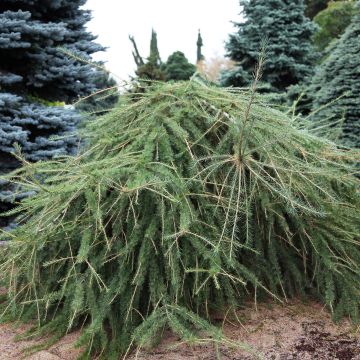
Comments